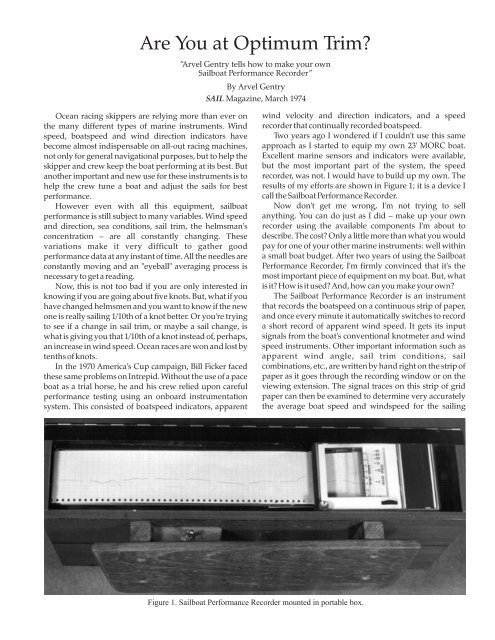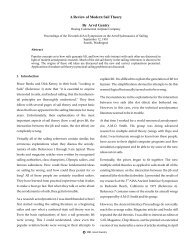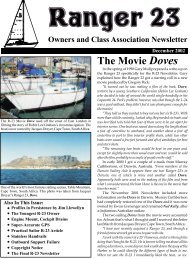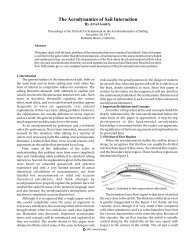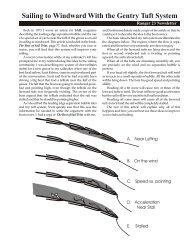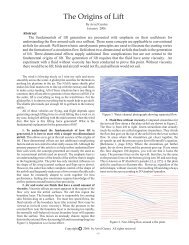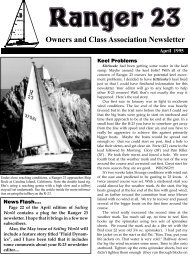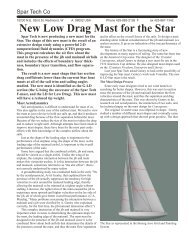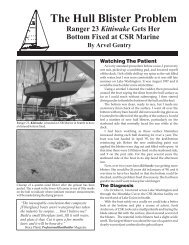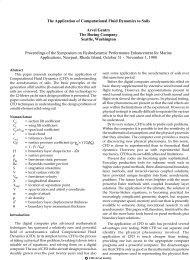Are You at Optimum Trim? - ArvelGentry.com
Are You at Optimum Trim? - ArvelGentry.com
Are You at Optimum Trim? - ArvelGentry.com
You also want an ePaper? Increase the reach of your titles
YUMPU automatically turns print PDFs into web optimized ePapers that Google loves.
<strong>Are</strong> <strong>You</strong> <strong>at</strong> <strong>Optimum</strong> <strong>Trim</strong>?<br />
Ocean racing skippers are relying more than ever on<br />
the many different types of marine instruments. Wind<br />
speed, bo<strong>at</strong>speed and wind direction indic<strong>at</strong>ors have<br />
be<strong>com</strong>e almost indispensable on all-out racing machines,<br />
not only for general navig<strong>at</strong>ional purposes, but to help the<br />
skipper and crew keep the bo<strong>at</strong> performing <strong>at</strong> its best. But<br />
another important and new use for these instruments is to<br />
help the crew tune a bo<strong>at</strong> and adjust the sails for best<br />
performance.<br />
However even with all this equipment, sailbo<strong>at</strong><br />
performance is still subject to many variables. Wind speed<br />
and direction, sea conditions, sail trim, the helmsman's<br />
concentr<strong>at</strong>ion – are all constantly changing. These<br />
vari<strong>at</strong>ions make it very difficult to g<strong>at</strong>her good<br />
performance d<strong>at</strong>a <strong>at</strong> any instant of time. All the needles are<br />
constantly moving and an "eyeball" averaging process is<br />
necessary to get a reading.<br />
Now, this is not too bad if you are only interested in<br />
knowing if you are going about five knots. But, wh<strong>at</strong> if you<br />
have changed helmsmen and you want to know if the new<br />
one is really sailing 1/10th of a knot better. Or you're trying<br />
to see if a change in sail trim, or maybe a sail change, is<br />
wh<strong>at</strong> is giving you th<strong>at</strong> 1/10th of a knot instead of, perhaps,<br />
an increase in wind speed. Ocean races are won and lost by<br />
tenths of knots.<br />
In the 1970 America's Cup campaign, Bill Ficker faced<br />
these same problems on Intrepid. Without the use of a pace<br />
bo<strong>at</strong> as a trial horse, he and his crew relied upon careful<br />
performance testing using an onboard instrument<strong>at</strong>ion<br />
system. This consisted of bo<strong>at</strong>speed indic<strong>at</strong>ors, apparent<br />
“Arvel Gentry tells how to make your own<br />
Sailbo<strong>at</strong> Performance Recorder”<br />
By Arvel Gentry<br />
SAIL Magazine, March 1974<br />
wind velocity and direction indic<strong>at</strong>ors, and a speed<br />
recorder th<strong>at</strong> continually recorded bo<strong>at</strong>speed.<br />
Two years ago I wondered if I couldn't use this same<br />
December 1999<br />
approach as I started to equip my own 23' MORC bo<strong>at</strong>.<br />
Excellent marine sensors and indic<strong>at</strong>ors were available,<br />
but the most important part of the system, the speed<br />
recorder, was not. I would have to build up my own. The<br />
results of my efforts are shown in Figure 1; it is a device I<br />
call the Sailbo<strong>at</strong> Performance Recorder.<br />
Now don't get me wrong, I'm not trying to sell<br />
anything. <strong>You</strong> can do just as I did – make up your own<br />
recorder using the available <strong>com</strong>ponents I'm about to<br />
describe. The cost? Only a little more than wh<strong>at</strong> you would<br />
pay for one of your other marine instruments: well within<br />
a small bo<strong>at</strong> budget. After two years of using the Sailbo<strong>at</strong><br />
Performance Recorder, I'm firmly convinced th<strong>at</strong> it's the<br />
most important piece of equipment on my bo<strong>at</strong>. But, wh<strong>at</strong><br />
is it? How is it used? And, how can you make your own?<br />
The Sailbo<strong>at</strong> Performance Recorder is an instrument<br />
th<strong>at</strong> records the bo<strong>at</strong>speed on a continuous strip of paper,<br />
and once every minute it autom<strong>at</strong>ically switches to record<br />
a short record of apparent wind speed. It gets its input<br />
signals from the bo<strong>at</strong>'s conventional knotmeter and wind<br />
speed instruments. Other important inform<strong>at</strong>ion such as<br />
apparent wind angle, sail trim conditions, sail<br />
<strong>com</strong>bin<strong>at</strong>ions, etc., are written by hand right on the strip of<br />
paper as it goes through the recording window or on the<br />
viewing extension. The signal traces on this strip of grid<br />
paper can then be examined to determine very accur<strong>at</strong>ely<br />
the average bo<strong>at</strong> speed and windspeed for the sailing<br />
Figure 1. Sailbo<strong>at</strong> Performance Recorder mounted in portable box.
conditions present.<br />
This check of the record can be made just after the<br />
signals are recorded, or many hours l<strong>at</strong>er when a gre<strong>at</strong><br />
number of records can be evalu<strong>at</strong>ed and <strong>com</strong>pared. A<br />
typical output strip from the recorder is shown in Figure 2.<br />
Bo<strong>at</strong>speed is linear and can be read directly from the grid<br />
lines. However the wind speed is non-linear because of the<br />
output signal from the Telcor wind instrument th<strong>at</strong> I used.<br />
Wind speed is read with a small calibr<strong>at</strong>ion scale, and this<br />
has turned out to be an advantage because it gives good<br />
accuracy <strong>at</strong> the lower wind speeds where you need it.<br />
The Sailbo<strong>at</strong> Performance Recorder consists of a<br />
<strong>com</strong>mercially available strip recorder, control and filter<br />
circuits to prepare the bo<strong>at</strong> instrument signals for the<br />
recorder, a relay switching circuit to change autom<strong>at</strong>ically<br />
the recorded signal, and a housing box to protect the<br />
instrument as well as make it portable. The recorder I used<br />
was a 10 millivolt DC Rustrak recorder which is used in<br />
many non-bo<strong>at</strong>ing electronic applic<strong>at</strong>ions. The rest of the<br />
required electronics, the control, filter and switching<br />
circuits, are very simple and you can wire them up<br />
yourself. Or, if you're not so inclined, you can have your<br />
local marine radio repairman do it for you.<br />
I use the Sailbo<strong>at</strong> Performance Recorder in<br />
tuning/practice sessions and in actual races. The procedure<br />
used in the testing sessions is simple and straightforward.<br />
Once the bo<strong>at</strong> is stabilized for a given set of sail and bo<strong>at</strong><br />
trim conditions, the recorder is turned on. It then<br />
autom<strong>at</strong>ically records the bo<strong>at</strong>speed on a continuous strip<br />
of paper. Periodic short wind speed records are also made<br />
by the autom<strong>at</strong>ic switching system.<br />
At the end of the test run, I turn the recorder off, change<br />
the sail settings, and repe<strong>at</strong> the procedure on the next test.<br />
Other significant inform<strong>at</strong>ion is written right on the strip<br />
paper with a pencil, and this usually includes the <strong>com</strong>pass<br />
heading, rel<strong>at</strong>ive wind direction and any sail setting d<strong>at</strong>a<br />
(distance off spreader, genoa car position, halyard tension,<br />
etc.). Sometimes this inform<strong>at</strong>ion is written on a separ<strong>at</strong>e<br />
test log sheet or is recorded on a cassette magnetic recorder<br />
for subsequent correl<strong>at</strong>ion with the strip recorder, wind<br />
speed, and bo<strong>at</strong>speed traces.<br />
The strip recorder has a viewing extension so th<strong>at</strong> about<br />
10 minutes of the strip record is in view before the paper<br />
feeds back into the recorder take-up spool. I consider this<br />
an important fe<strong>at</strong>ure. If the recorder did not have this<br />
-2-<br />
Figure 2. Typical output from<br />
strip can be marked to show<br />
when changes in trim took place.<br />
extension and the paper stayed within the recorder, it is<br />
not so useful in a real sailing applic<strong>at</strong>ion.<br />
At the end of a test day, I take the paper from the<br />
recorder and study and <strong>com</strong>pose the records. If a given<br />
change in sail trim between two records gives an increase<br />
in average bo<strong>at</strong>speed (and the recorded wind speeds have<br />
not changed significantly), then I have found a way of<br />
making the bo<strong>at</strong> go faster. Each test condition is usually<br />
repe<strong>at</strong>ed several times to verify the actual amount of speed<br />
improvement. The same type of procedure is used in<br />
testing different sail <strong>com</strong>bin<strong>at</strong>ions.<br />
The Sailbo<strong>at</strong> Performance Recorder is also used in<br />
actual racing conditions. All sail selection and trim changes<br />
are checked before and after they are made by reading the<br />
average bo<strong>at</strong>speed and wind speed from the strip recorder.<br />
This is especially helpful on longer races when there are no<br />
other bo<strong>at</strong>s close by to <strong>com</strong>pare with visually. On short day<br />
races I leave the strip recorder running during the entire<br />
race. It is very interesting to look back on these records and<br />
see if the bo<strong>at</strong> was sailed up to its full potential, and to see<br />
how much time was lost in bad spinnaker sets, etc.<br />
A strip recorder makes it very easy to g<strong>at</strong>her the d<strong>at</strong>a<br />
necessary to construct a <strong>com</strong>plete speed polar for your<br />
bo<strong>at</strong>. Such a polar will help in making the proper sail<br />
selection for different wind conditions. The recorder is also<br />
useful in making a direct and accur<strong>at</strong>e <strong>com</strong>parison of the<br />
performance of different helmsmen. During very short<br />
races, the cassette magnetic tape recorder can be used to<br />
record supplementary d<strong>at</strong>a such as apparent wind angles,<br />
sail trim changes and crew positions.<br />
The main use of the recorder in all these applic<strong>at</strong>ions is<br />
to determine accur<strong>at</strong>e average bo<strong>at</strong>speeds and wind<br />
speeds over a period of sailing time. This is very difficult to<br />
do just by looking <strong>at</strong> the knotmeter and wind speed dials.<br />
Most important of all, the strip recorder provides a<br />
permanent record for l<strong>at</strong>er study under more relaxed nonsailing<br />
conditions.<br />
My recording instrument itself is a Model No. 2194<br />
Rustrak Recorder (range 0 to 10 millivolts) with a 12volt DC<br />
unregul<strong>at</strong>ed drive motor (10 rpm). The actual paper chart<br />
speed is determined by the drive motor rpm and the<br />
interchangeable gear train selected. Rustrak gear train # 15<br />
and the 10-rpm motor gives a paper speed of 75" per hour.<br />
After trying several different paper speeds, this speed<br />
seems to be best for most applic<strong>at</strong>ions. With the 75"/hr
paper speed, one roll of paper will last 10 hours. The other<br />
Rustrak item needed is the Model 223 Chart Viewing<br />
Extension. The total cost of the Rustrak recorder and<br />
accessories is approxim<strong>at</strong>ely $250 (Rustrak Instrument Div.<br />
Gulton Industries, Manchester, New Hampshire 03103).<br />
The only other item is the chart paper itself. A number<br />
of different recorder chart paper styles are available from<br />
Rustrak. I use style WB chart paper which gives a full scale<br />
reading of 7.5 knots with grid lines <strong>at</strong> 1/10 knot intervals.<br />
Once you have the strip recorder and your knotmeter<br />
and wind speed instruments you'll have to build circuits to<br />
hook the recorder and instruments together. This consists<br />
of circuits to fine-tune the recorded signals so th<strong>at</strong> they<br />
m<strong>at</strong>ch the marine instruments, and to dampen the<br />
recorded traces to aid in giving a better average bo<strong>at</strong>speed<br />
and wind speed readings. The bo<strong>at</strong>speed circuit is shown<br />
in Figure 3. The variable resistance <strong>at</strong> R2 is the control used<br />
to adjust the recorded signal trace so th<strong>at</strong> it m<strong>at</strong>ches exactly<br />
the knotmeter instrument reading. The value of resistor R1<br />
will depend upon which knotmeter you use. I used a Telcor<br />
knotmeter with the R1 value shown in Figure 3.<br />
The wind speed connection circuit is shown in Figure 4.<br />
Again, the Telcor wind speed indic<strong>at</strong>or was used and R3<br />
had a fixed value of 3.3K. However with other brands, I<br />
would re<strong>com</strong>mend th<strong>at</strong> R3 be variable as shown. Consult<br />
your own instrument manufacturer for the proper values<br />
to use for resistors R1 and R3 in these circuits, or calcul<strong>at</strong>e<br />
them yourself using the equ<strong>at</strong>ion given in the Rustrak<br />
owner's manual.<br />
These resistors must step the marine instrument<br />
signals down so as not to exceed the maximum 10 millivolt<br />
signal toler<strong>at</strong>ed by the Rustrak recorder. The capacitors in<br />
Figure 3. Bo<strong>at</strong>speed circuit.<br />
Figure 4. Wind speed circuit.<br />
Figure 5. Switching circuit.<br />
-3-<br />
the circuits are all electrolytics and are used to help smooth<br />
out and filter the signals to minimize the trace wiggles. The<br />
different amounts of filtr<strong>at</strong>ion and the different character<br />
of the bo<strong>at</strong>speed and wind speed traces makes it very easy<br />
to tell which is which.<br />
Once the input signals are ready for the strip recorder,<br />
you need a means of autom<strong>at</strong>ically switching the signals,<br />
for the recorder is only able to record one signal <strong>at</strong> a time.<br />
The circuit for this is shown in Figure 5. To activ<strong>at</strong>e the<br />
switching circuit, I use the flange on the Rustrak recorder<br />
take-up spool itself. I added a small contact point insul<strong>at</strong>ed<br />
from the recorder frame and th<strong>at</strong> rides on the spool flange.<br />
The circuit is broken whenever the contact point is lifted by<br />
a piece of tape on the flange. Splicing tape used for<br />
magnetic recording tape seems best for this.<br />
The width and number of tapes on the spool flange<br />
control how often the switch is made between bo<strong>at</strong>speed<br />
and wind speed. Two 1/4" pieces of tape give about 12<br />
seconds of wind speed every minute. The transistorized<br />
switching circuit shown in Figure 5 controls the relay th<strong>at</strong><br />
actually switches the signals being sent to the Rustrak<br />
recorder.<br />
To drive the recorder and switching relay circuit you<br />
need a 12-volt b<strong>at</strong>tery source. Normally, the recorder can<br />
be powered by the bo<strong>at</strong>'s 12-volt b<strong>at</strong>tery. However, with<br />
the Telcor windspeed instrument, the Rustrak recorder<br />
had to be driven by a separ<strong>at</strong>e 12-volt source because of the<br />
+6-volt reference voltage used by Telcor. Because of this,<br />
and the desire to make the unit <strong>com</strong>pletely portable, I<br />
included a Rustrak rechargable b<strong>at</strong>tery pack (model 154A-<br />
12-400) though a regular 12-volt dry cell can be used just as<br />
well.<br />
The final task is to build a box to hold and protect the<br />
recorder and control circuits from the marine<br />
environment. I <strong>at</strong>tached a small h<strong>at</strong>ch board to the box so<br />
th<strong>at</strong> it could be conveniently positioned in the<br />
<strong>com</strong>panionway. Since the unit is portable I can take the<br />
whole box home after a race to remove the paper and<br />
recharge the b<strong>at</strong>tery.<br />
The top of the box is a hinged piece of Plexiglas to keep<br />
out spray. A manual switch is added <strong>at</strong> the b<strong>at</strong>tery source<br />
to turn the recorder on and off. I also added a double throw<br />
switch so th<strong>at</strong> I could record bo<strong>at</strong>speed only, wind speed<br />
only, or have the signals switched on autom<strong>at</strong>ically. Figure<br />
6 shows all the unit <strong>com</strong>ponents; the b<strong>at</strong>tery is in the<br />
bottom of the box. Then the two circuit boxes go in on top<br />
and they are followed by the Rustrak recorder. The b<strong>at</strong>tery<br />
and circuit boxes lie underne<strong>at</strong>h the chart-viewing<br />
extension.<br />
If making your own recorder, connecting, and<br />
switching circuits is too much work for you, contact Signet<br />
Scientific Company, 129 E. Tojunga Ave., Burbank,<br />
California 91503. I believe they now are selling strip<br />
recorders for use with their instruments <strong>at</strong> about $500 per<br />
single channel device. I am told th<strong>at</strong> some of the new large<br />
ocean-racing bo<strong>at</strong>s are ordering as many as four and five of<br />
these recorders to record everything from wind speed,
Figure 6. Detail of Sailbo<strong>at</strong> Performance Recorder<br />
<strong>com</strong>ponents.<br />
bo<strong>at</strong>speed, heading, rudder angle; probably even the<br />
heartbe<strong>at</strong> of the helmsman! However, if you are on a small<br />
bo<strong>at</strong> budget, you can make your own Sailbo<strong>at</strong><br />
Performance Recorder as I did, and still have virtually the<br />
same equipment as the big boys!<br />
-4-


